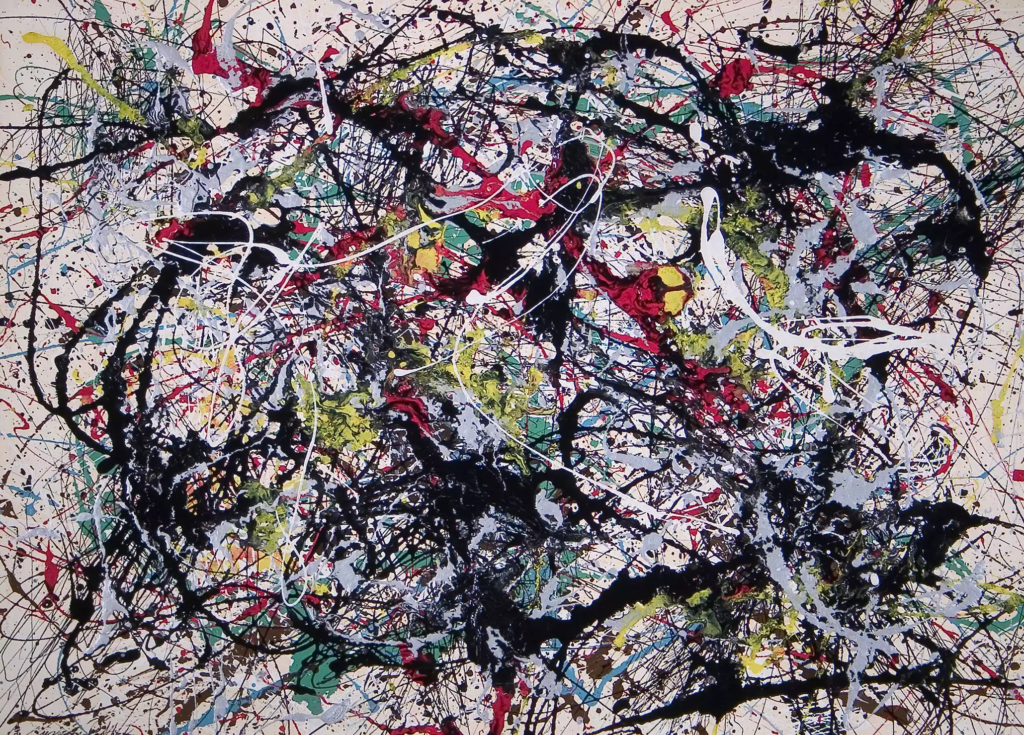“Abstract painting is abstract. It confronts you. There was a reviewer a while back who wrote that my pictures didn’t have any beginning or any end. He didn’t mean it as a compliment, but it was.” – Jackson Pollock
Jackson Pollock’s painting technique was far from conventional. Not only were his canvases typically laying on the floor instead of standing upright on an easel during his process, but his paintbrush or whatever his tool of choice was rarely ever touched the surface of the canvas.
While the style of action painting had been experimented with before, “drip painting” would ultimately become synonymous with the name Jackson Pollock. To Pollock, the abstract art technique of dripping and pouring paint onto a canvas was more than mindlessly splattering and dripping paint on a horizontal surface. There was a method to the madness – one that would gain Pollock the attention of the art world.

Splashy, Drippy and Messy – I Am Nature
In 1956, Pollock told Time magazine, “I continue to get further away from the usual painter’s tools such as easel, palette, brushes, etc. I prefer sticks, trowels, knives and dripping fluid paint or a heavy impasto with sand, broken glass or other foreign matter added.”
Despite Pollock’s eventual resistance to traditional techniques, he did undergo conventional training when he studied under American painter and muralist Thomas Hart Benton at the Art Students League. Benton was at the forefront of the Regionalist art movement or modern art, depicting realistic scenes of rural America. It appears that despite his long apprenticeship, he ultimately chose to depart from traditional techniques.
When it comes to Jackson “Jack the Dripper” Pollock’s work, it’s either you get it, or you don’t. Pollock’s detractors would argue that his pieces from the “drip period” can easily be replicated by a toddler or even a chimp, insinuating that anyone with the dexterity to hold a brush could create an abstract work of art.

Jack The Dripper, The Greatest Painter
However, those who have tried to recreate a composition that evokes Pollock quickly discover that the technique requires focus, purpose, and technical knowledge of how paint flows, splashes, and hits the canvas. It demanded an understanding of the unique texture of paint and its gravitational behavior. There was precision with each flick of Pollock’s wrist as he released paint unto a canvas. There was certainly nothing random nor accidental about each spill and splatter.
And whether you believe Pollock’s work was genius or garbage, the fact remains that Pollock is widely recognized as one of the most important artists of his time. In 1949, LIFE magazine cements Pollock’s reputation by directly asking “Is he the greatest living painter in the United States?”

Today, Jackson Pollock remains one of the most recognizable Abstract Expressionists; his work from the “drip period” selling for hundreds of millions. His No. 5, 1948 (artwork image above) sold for $140 million. And when his Number 17A (1948) sold for $200 million, that placed the Pollock piece as one of the top 5 most expensive works of art of all time.



![[Left] Kusama with her piece Dots Obsession, 2012, via AWARE, [Right] Yayoi Kusama (Courtesy Whitney Museum of American Art) | Source: thecollector.com](https://www.artdex.com/wp-content/uploads/2024/04/Left-Kusama-with-her-piece-Dots-Obsession-2012-via-AWARE-Right-Yayoi-Kusama-Courtesy-Whitney-Museum-of-American-Art-Source-thecollector.com--300x172.png)



